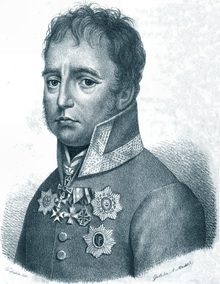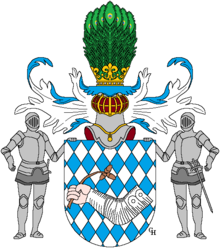Johann von Prochaska-Coronini
Johann Freiherr von Prochaska-Coronini (born July 3, 1760 in Vienna ; † April 24, 1823 ibid) was a Lieutenant Field Marshal of the Austrian Empire , Chief of the Quartermaster General and owner of the Italian Infantry Regiment No. 38.
Life
Johann came from a Bohemian family whose father was employed in the public service in Vienna. He became interested in the arms trade at an early age and on March 8, 1778 , he was assented to the imperial artillery as a gunner and went through the graduation of this scientific corps faster than usual. So he advanced on April 4, 1784 to lieutenant . During the preparations for war against the Turks was called on December 16, 1787 the newly formed pioneer - Corps with promotion to lieutenant and the employment with the Army Corps of Field Marshal Gideon Ernst Freiherr von Laudon , then on May 29, 1789 General Staff of the Army corps gathered at the border of Moravia and Silesia, where he was promoted to captain on February 14, 1790 . In 1792 he was appointed to the Quartermaster General under Lieutenant Field Marshal Jean-Pierre de Beaulieu (1725-1819) in the Netherlands .
On June 30, 1793, Prochaska was appointed major because of his ability . His attacks, carried out under the eyes of the emperor, on the cantonal line supported and entrenched at Landrecy , Guise and St. Quentin on April 17, 1794, his use in the two heated battles in front of Landrecy on April 24 and 26 of that year as well as the Defense of the threatened position on the Waal from 9th to 26th January 1795.

After both his supreme superior, Field Marshal Duke von Coburg , and the head of his department, General Freiherr von Alvincy, repeatedly asked the Kaiser to honor the officer, Prochaska was promoted to lieutenant colonel on February 29, 1796 and on May 11 of the year honored with the Knight's Cross for the Military Maria Theresa Order . He was also raised to the nobility with the predicate "Edler von Prohaska", with the right to later elevation to the Austrian baron . Finally, he got on the orders of the Commander Graf von Wurmser on May 21 of the year the post of Chief of Staff in the Army Corps of Feldzeugmeister Count Baillet Latour (1737-1806) where he, among other things by his skills in the position at Friedberg on August 24th of the year as well as after General Moreau's unexpected crossing over the Rhine in the battle near Bischofsheim on April 21st, 1797 proved to be very useful for the general.
In 1799, the officer came as chief of the General Quatiermeisterstab department under the leadership of Field Marshal Lieutenant Count von Bellegarde , where he moved with him to Northern Italy and again distinguished himself in the battle on the Bormida on June 20 that year, but was also wounded. In recognition of his achievements, he was promoted to colonel a few weeks later, on August 31, 1799 . After the war broke out again in 1800, at the request of the British Army Minister Wickham, Prochaska, on the proposal of the Court War Council, was appointed by the Kaiser to set up and manage an aid contingent from the Palatinate and Bavaria . In this he was very successful: on April 3, 1801 he reported a first detachment with 6,889 soldiers on foot and 572 on horseback from Donauwörth and on September 6 of that year a second from Amberg with 11,910 men on foot and 1,106 riders .
After promotion to major general on September 1, 1805 (with rank of January 18, 1804) he was employed in the General Staff of the Italian Army. After the end of the campaign, he led an infantry brigade to their peace deployment in Salzburg , where he kept command until the war broke out again and he was appointed Chief of Staff of the Army in Germany. On May 27 of that year he moved to field marshal lieutenant and commander of Grenadier - Division . With this he took part in the battle of Wagram on July 5 and 6, 1809 as a division commander.
From 1813 he was " General Director " responsible for supplying and replenishing the army in the constantly expanding theaters of war. In 1815 he became the owner of the Italian Infantry Regiment No. 38. Immediately after the end of the war , he was appointed to the Court War Council, and in 1816 he was appointed Chief of the Quartermaster General. He held this post until the end of his life (1823).
The elevation to the hereditary- Austrian baron class with the predicate "Baron von Prohaska-Coronini" finally took place on November 9, 1820 in Vienna with a diploma of January 19, 1821.
Prochaska was buried in the Sankt Marxer Friedhof in today's 3rd district of Vienna Landstrasse .
Orders and decorations
The baron was honored with numerous awards, including:
- Knight's Cross of the Military Maria Theresa Order (1796)
- Knight's Cross of the Austrian Leopold Order
- Imperial Russian Order of St. Anna 1st Class
- Royal Prussian Order of the Red Eagle 2nd class
- Grand Cross of the Royal Bavarian Order of Civil Merit
- Grand Cross of the Badenscher Zähringer Lion Order
- Commander of the Württemberg Military Merit Order
coat of arms
1820: In shields covered with blue and silver diamond chess, a silver armored right arm, holding a natural branch with three acorns in his bare hand. Seven natural peacock feathers on the helmet with its blue and silver covers. Shield holder: two harnesses with closed visors.
literature
- Johann Ritter von Rittersberg: Biographies of the most distinguished deceased and living generals of the Imperial and Royal Austrian Army from the period of the campaigns 1788–1821 , Part 2, Verlag CW Enders, Prague 1828.
- Constantin von Wurzbach : Prohaska, Johann Freiherr von . In: Biographisches Lexikon des Kaiserthums Oesterreich . 23rd part. Kaiserlich-Königliche Hof- und Staatsdruckerei, Vienna 1872, pp. 336–339 ( digitized version ).
- Adolf Schinzl: Prohaska, Johann Freiherr von . In: Allgemeine Deutsche Biographie (ADB). Volume 26, Duncker & Humblot, Leipzig 1888, pp. 628-630.
- Antonio Schmidt-Brentano: Imperial and Imperial and Royal Generals (1618–1815), Austrian State Archives / A. Schmidt-Brentano 2006.
Web links
Individual evidence
- ^ A b Johann Ritter von Rittersberg: Biographies of the most distinguished deceased and living generals of the Imperial and Royal Austrian Army from the period of the campaigns 1788–1821 , Part 2, Verlag CW Enders, Prague 1828, p. 507 ff.
- ^ Antonio Schmidt-Brentano: Imperial and Imperial Generals (1618-1815), Austrian State Archives / A. Schmidt-Brentano 2006, p. 78
- ^ Ian Castle: "Aspern & Wagram 1809: Mighty Clash of Empires", Osprey Publishing Ltd, London 1994, p. 21
- ^ Military Schematism of the Austrian Empire, from derk. k. Hof- und Staats-Druckerey, Vienna 1817, p. 223
- ^ Genealogisches Handbuch des Adels , Adelslexikon Volume XI, Volume 122 of the complete series, CA Starke Verlag, Limburg (Lahn) 2000, ISSN 0435-2408
- ^ Hans Pemmer: The cemetery at St. Marx in Vienna, his dead, his grave monuments , publisher of the Office for Culture and National Education, Department of Heimatpflege, 1951
- ↑ Hof- und Staatsschematismus des Österreichischen Kaiserthums, part 1, kk Hof- und Staats- Aerarial-Druckerey, Vienna 1817, p. 268
- ↑ http://www.coresno.com/index.php/adelslexikon/1414-lex-prochaska1820
| personal data | |
|---|---|
| SURNAME | Prochaska-Coronini, Johann von |
| ALTERNATIVE NAMES | Prochaska, Johann Freiherr von; Prochaska-Coronini, Johann Freiherr von (full name) |
| BRIEF DESCRIPTION | Austrian Lieutenant Field Marshal |
| DATE OF BIRTH | July 3, 1760 |
| PLACE OF BIRTH | Vienna |
| DATE OF DEATH | April 24, 1823 |
| Place of death | Vienna |

